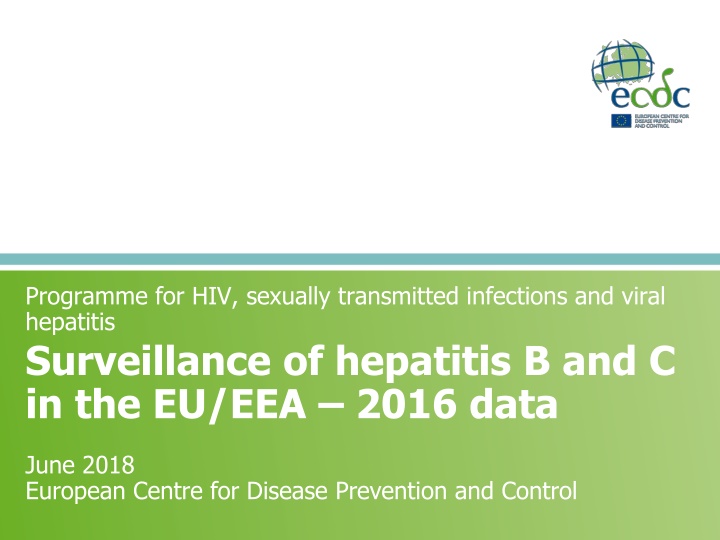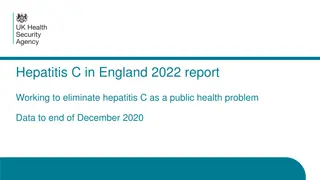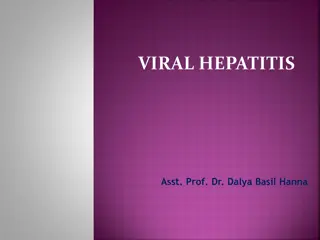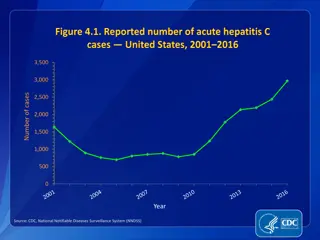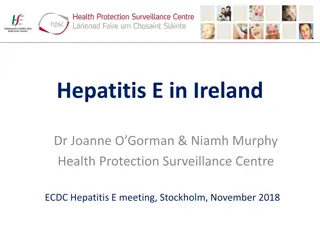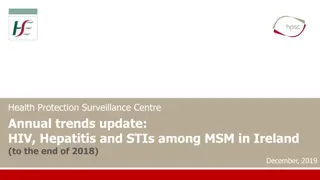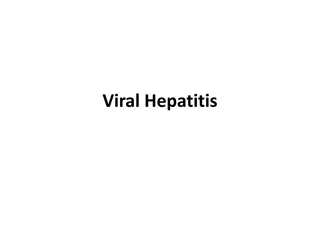Surveillance and Trends of Hepatitis B Infections in EU/EEA
Surveillance program coordinated by ECDC for Hepatitis B and C infections in EU/EEA countries. Data collection, case definitions, trends, and distribution of Hepatitis B cases in 2016 reported by 30 countries. Insights into acute and chronic cases, reported rates per 100,000 population, and country-specific data.
Download Presentation

Please find below an Image/Link to download the presentation.
The content on the website is provided AS IS for your information and personal use only. It may not be sold, licensed, or shared on other websites without obtaining consent from the author.If you encounter any issues during the download, it is possible that the publisher has removed the file from their server.
You are allowed to download the files provided on this website for personal or commercial use, subject to the condition that they are used lawfully. All files are the property of their respective owners.
The content on the website is provided AS IS for your information and personal use only. It may not be sold, licensed, or shared on other websites without obtaining consent from the author.
E N D
Presentation Transcript
Programme for HIV, STI and Viral Hepatitis B and C infections Programme for HIV, sexually transmitted infections and viral hepatitis Surveillance of hepatitis B and C Surveillance of hepatitis B and C in the EU/EEA 2016 data in the EU/EEA 2016 data April 2018 June 2018 European Centre for Disease Prevention and Control European Centre for Disease Prevention and Control
Surveillance of hepatitis B and C principles Surveillance programme coordinated by ECDC Data from EU/EEA countries are uploaded annually into the European Surveillance System (TESSy) a purpose-built web-based system for data collection Case-based and aggregate reporting possible Countries requested to follow the EU 2012 case definitions, including acute and newly diagnosed chronic infections Data collected on 35 variables Data validated by Member States
Hepatitis B data: reporting countries and case definitions used 30 countries provided hepatitis B data in 2016 Five countries could only provide data on acute cases Case definitions varied: 22 countries used the EU 2012 case definition Four countries used the EU 2008 case definition Four countries used national case definitions Aggregate data from two countries (Bulgaria, Croatia)
Hepatitis B data: distribution by disease status, EU/EEA, 2016 In 2016 29 307 cases reported* (5.5 per 100 000) Acute: 2 529 (8.6%) Chronic: 17 662 (60%) Unknown: 8 780 (30%) * 336 (1%) could not be classified by disease status due to incompatible format of the data provided
Rate of reported acute hepatitis B cases per 100 000 population by country, 2016* * UK data exclude Scotland
Rate of reported chronic hepatitis B cases per 100 000 population by country, 2016* * UK data exclude Scotland
Rates of acute and chronic hepatitis B cases in EU/EEA countries, 2007 2016 Chronic Acute 20 Rate per 100 000 population 10 0 2007 2008 2009 2010 2011 2012 2013 2014 2015 2016 Acute cases: Country reports from: Denmark, Estonia, Finland, France*, Germany, Greece, Hungary, Ireland, Latvia, the Netherlands, Norway, Romania, Slovakia, Slovenia, Sweden, and the United Kingdom**. Chronic cases: Country reports from: Denmark, Estonia, Finland, Ireland, Latvia, the Netherlands, Norway, Slovakia, Slovenia, Sweden, and the United Kingdom**. * Underreporting of acute hepatitis B in France was estimated at 76.5% in 2013. ** UK data exclude Scotland.
Hepatitis B data: distribution by age, transmission and importation status, 2016 29.5% of cases were aged between 25 and 34; 11.9% of acute cases and 12.3% of chronic cases aged under 25 Male-to-female rate ratio: 1.7 to 1 Transmission mode (18% complete): - Most common acute: Heterosexual transmission (30%); nosocomial (17%); transmission among men who have sex with men (12%); injecting drug use (10%) - Most common chronic: nosocomial transmission (33%); mother-to- child transmission (32%) Migration variables poorly reported but 47% of cases with complete information were classified as imported ; 87% of imported infections were chronic
Rate of reported hepatitis B cases per 100 000 by age and disease status, 2016 25 20 Rate per 100 000 population 15 Acute Chronic 10 5 0 <5 5 14 15 19 20 24 25 34 35 44 45 54 55 64 65 Age group (years) Source: Country reports from: Austria, Czech Republic, Denmark, Estonia, Finland, France*, Germany, Greece, Hungary, Iceland, Ireland, Latvia, Lithuania, Luxembourg, Malta, the Netherlands, Norway, Poland, Portugal, Romania, Slovakia, Slovenia, Spain, Sweden, and the United Kingdom**. * Underreporting of acute hepatitis B in France was estimated at 76.5% in 2013. ** Note that UK data exclude Scotland.
Reported transmission category for acute and chronic hepatitis B cases, 2016 Heterosexual transmission Nosocomial (includes hospital, nursing home, etc.) Men who have sex with men (MSM) Non-occupational injuries (needle-stick, bites, tattoos, piercings) Injecting drug use Transmission category Other Sexual transmission (not specified) Household Acute Blood and blood products Chronic Mother-to-child transmission Needle-stick and other occupational exposure Haemodialysis Organ and tissues 0 5 10 15 20 25 30 35 Proportion of cases (%) Source: Country reports from: Country reports from: Austria, Denmark, Estonia, Finland, France, Germany, Hungary, Ireland, Italy, Latvia, Lithuania, Malta, the Netherlands, Norway, Poland, Portugal, Romania, Slovakia, Spain and Sweden.
Hepatitis C data: reporting countries and case definitions used 29 countries provided hepatitis C data in 2016 Three countries could only provide data on acute cases Case definitions varied: 20 countries used the revised EU case definition Five countries used the EU 2008 case definition Four countries used national case definitions Aggregate data from two countries (Bulgaria, Croatia)
Hepatitis C data: distribution by disease status, EU/EEA, 2016 In 2016, 33 860 hepatitis C cases* were notified representing a rate of 7.4 cases per 100 000: 813 (2.4%) acute 7 386 (22%) chronic 25 396 (75%) unknown** * 265 cases (1%) could not be classified by disease status due to incompatible format of the data provided ** As acute hepatitis C is difficult to diagnose clinically or serologically, most unknown cases are likely to be chronic infections.
Rate of all reported hepatitis C cases across EU/EEA countries, 2007-2016 14 12 Rate per 100 000 population 10 8 6 4 2 0 2007 2008 2009 2010 2011 2012 2013 2014 2015 2016 Year Source: Country reports from: Austria, Czech Republic, Denmark, Estonia, Finland, Germany, Greece, Hungary, Ireland, Latvia, Malta, Norway, Romania, Slovakia, Slovenia, Sweden, and the United Kingdom.
Rate of reported hepatitis C cases per 100 000 population by country, 2016* * Countries not reporting any data or reporting data only on acute cases are excluded.
Hepatitis C: distribution by age, transmission and importation status, 2016 52% of cases were aged between 25 and 44 - 7% were aged under 25 The overall male-to-female rate ratio was 1.9 to 1 Transmission mode (26% complete): Most common acute: injecting drug use (37%); nosocomial (18%); men who have sex with men (13%) Most common chronic: injecting drug use (50%); nosocomial (19%); blood and blood products (12%) 18% of cases with complete information were classified as imported
Rate of reported hepatitis C cases per 100 000 by age and gender, 2016 25 20 Male Rate per 100 000 population Female 15 10 5 0 <5 5 14 15 19 20 24 25 34 35 44 45 54 55 64 65 Age group (years) Source: Country reports from: Austria, Cyprus, Czech Republic, Denmark, Estonia, Finland, Germany, Greece, Hungary, Iceland, Ireland, Italy, Latvia, Lithuania, Luxembourg, Malta, the Netherlands, Norway, Portugal, Romania, Slovakia, Slovenia, Spain, Sweden, and the United Kingdom.
Reported transmission category for acute and chronic hepatitis C cases, 2016 Injecting drug use Nosocomial (includes hospital, nursing home, etc.) Men who have sex with men (MSM) Heterosexual transmission Transmission category Sexual transmission (not specified) Other Non-occupational injuries (needle stick, bites, tattoos, piercings) Haemodialysis Acute Needle-stick and other occupational exposure Blood and blood products Chronic Mother-to-child transmission Household 0 10 20 30 40 50 60 Proportion of cases (%) Source: Country reports from: Austria, Denmark, Estonia, Hungary, Iceland, Ireland, Italy, Latvia, Lithuania, Malta, the Netherlands, Poland, Portugal, Romania, Slovakia, Slovenia, Spain, Sweden, and the United Kingdom.
Summary of key findings High numbers of newly diagnosed hepatitis B and C cases notified across Europe Hepatitis C more commonly reported than hepatitis B Chronic cases dominate across both diseases Marked variation between countries Hepatitis B: a decrease in acute cases Hepatitis C: strong north-south geographical trend Transmission routes for hepatitis B differ from hepatitis C, and for hepatitis B these routes vary by disease status Imported cases are significant, especially for hepatitis B
Key limitations of the data Due to the largely asymptomatic nature of hepatitis infections, data are strongly related to local testing practices Challenges relating to the case definitions: Different definitions used by countries Some countries only report acute hepatitis cases, especially for hepatitis B. High proportion of cases coded as unknown Data completeness low for certain variables: Transmission, genotype, complications, country of nationality, HCV status (for HBV cases), HBV status (for HCV cases), HIV status, sex worker, healthcare worker Underreporting major issue reported by some countries
Surveillance of hepatitis B and C epidemiological objectives 1. To monitor the incidence and routes of transmission of newly diagnosed cases of hepatitis B and C in the general and vulnerable populations 2. To monitor the prevalence of chronic hepatitis B and C virus infection to determine burden of infection (and estimate the proportion undiagnosed) in the general and vulnerable populations 3. To monitor the proportion of chronic cases that are engaged in care (continuum of care) 4. To monitor the proportion of newly diagnosed chronic cases presenting late 5. To determine genotype and sequence distributions of newly acquired infections to better follow transmission patterns, the emergence of resistance and vaccine escape mutants and potentially more virulent virus strains (priority on hepatitis C infections) 6. To determine and describe the proportion of co-infections (HIV/HBV/HCV/HDV) 7. To determine the proportion of HCV re-infections (especially among key risk groups with high incidence e.g. PWIDs)
Hepatitis B case definition Hepatitis B EU 2008 Case definition EU 2012 case definition Clinical criteria Any person with a discrete onset of symptoms (e.g. fatigue, abdominal pain, loss of appetite, intermittent nausea and vomiting) AND At least on of the following three: Fever Jaundice Elevated serum aminotransferase levels Not relevant for surveillance purposes Laboratory criteria Hepatitis B virus core IgM antigen specific antibody response Positive results of at least one or more of the following tests or combination of tests: IgM hepatitis B core antibody (anti-HBc IgM) Hepatitis B surface antigen (HBsAg) Hepatitis B e antigen (HBeAg) Hepatitis B nucleic acid (HBV-DNA) Laboratory results need to be interpreted according to vaccination status Epidemiological criteria An epidemiological link by human to human transmission (e.g. sexual contact, vertical transmission or blood transmission) N/A Case definition possible N/A N/A Case definition probable Any person meeting the clinical criteria and with an epidemiological link N/A Case definition confirmed Any person meeting the clinical and laboratory criteria Any person meeting the laboratory criteria The following combination of laboratory tests shall not be included or reported: Resolved hepatitis hepatitis B total core antibody (anti HBc) positive and hepatitis B surface antibody (anti HBs) positive Immunity following vaccination hepatitis B total core antibody (anti HBc) negative and hepatitis B surface antibody (anti HBs) positive Anti HBc IgG positivity only
Hepatitis C case definition Hepatitis C EU 2008 Case definition EU 2012 case definition Clinical criteria Not relevant for surveillance purposes Not relevant for surveillance purposes Laboratory criteria At least one of the following two: - Detection of hepatitis C virus nucleic acid in serum - Hepatitis C specific antibody response confirmed by a different antibody test At least one of the following three: - Detection of hepatitis C virus nucleic acid (HCV RNA) - Detection of hepatitis C virus specific antigen (HCV-core) - Hepatitis C virus specific antibody (anti-HCV) response confirmed by a confirmatory (e.g. immunoblot) antibody test in persons older than 18 months without evidence of resolved infection Epidemiological criteria N/A N/A Case definition - Possible N/A N/A Case definition - Probable N/A N/A Case definition - Confirmed Any person meeting the clinical and laboratory criteria Any person meeting the laboratory criteria The following combination of lab tests shall not be included or reported: Resolved infection: Detection of hepatitis C virus antibody and no detection of hepatitis C virus nucleic acid (HCV RNA negative result) or hepatitis C virus core antigen (HCV core negative result) in serum/plasma.
Differentiation of hepatitis C by stage of infection 1 In the event that the case was not notified the first time
Surveillance of hepatitis B and C: data completeness in 2016 Gender Age StageHEP Outcome Imported Country of nationality Transmission Testing location Hepatitis B Probable country infection Hepatitis C Sex worker status Complications Recent injector status Country of birth Healthcare worker status HIV status 0 10 20 30 40 50 60 70 80 90 100 Data completeness (%)
Acknowledgements Thank you to: The European Hepatitis B and C Network and Coordination Committee. EU/EEA country hepatitis and surveillance contact points. Surveillance colleagues at ECDC: Lina Nerlander, Erika Duffell, Catalin Albu, Julien Beaut , Denis Coulombier, Catia Cunha, Gaetan Guyodo, Franti ka Hruba, Valentina Lazdina, Phillip Zucs. Colleagues in the programme on HIV/AIDS, STI and Viral Hepatitis B and C: Lina Nerlander (main author), Andrew Amato-Gauci, Caroline Daamen. Contact: stihivhep@ecdc.europa.eu
